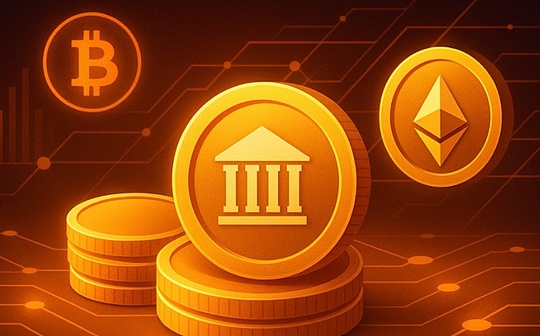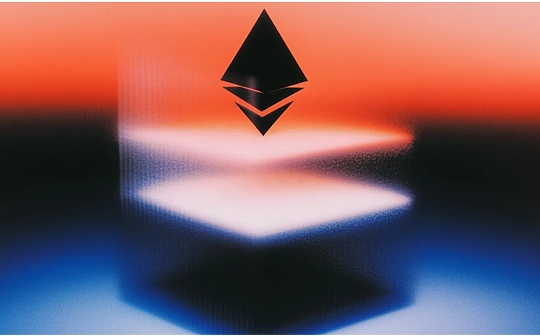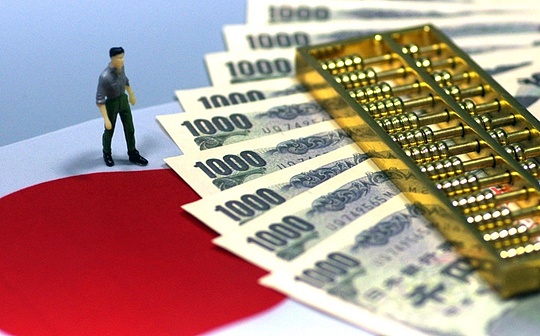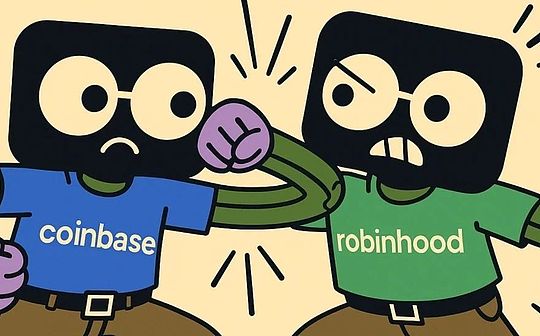
author:Thejaswini
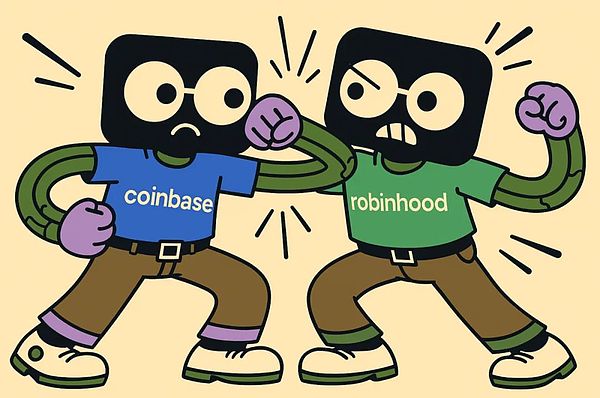
A war is going on in your pocket, and most people don’t even notice it.
Two of the largest financial applications in the United States are experimenting with millions of users in the exact opposite way.
Robinhood and Coinbase represent two very different expectations for financial applications.Robinhood ranks 14th in App Store financial applications and 20th in Coinbase.Both have a market capitalization of about $80 billion.
Both companies are chasing the same young investor community.Both parties believe that the other party’s approach is wrong.
One side bets people want financial applications to be as simple, intuitive, and invisible as other applications on their phones.Coinbase is committed to building an infrastructure that transitions from traditional finance to blockchain systems.
To some extent,Both experiments have achieved certain success.
This is the case with Robinhood and Coinbase, which are not traditional competitors.They perform completely different experiments on the same subject (us).
Robinhood looks at the finance field and proposes “What if we fix all the annoying parts?” They offer 15 cryptocurrencies, zero commission transactions, and an interface that can buy Tesla stocks without a finance degree.Their philosophy is that you don’t need to understand how sausage is made to have hot dogs.
Coinbase chooses the opposite direction.They propose “What if we rebuild the entire financial system on blockchain technology?” Coinbase costs more than competitors like Robinhood, but its platform is designed for those who want full access to the crypto ecosystem, offering over 260 cryptocurrencies.
They bet that traditional finance will eventually move to the chain and hope to be the infrastructure to drive this transformation.
Coinbase CEO Brian Armstrong said:“Our goal is to be the world’s leading financial services application over the next 5 to 10 years because we believe cryptocurrencies are eating up financial services and we are the number one crypto company. All these asset classes – money market funds, real estate, securities, debt – will be on the chain.”
Both companies went public several months apart in 2021, with market capitalization of about $80 billion, and are targeting the same generation of investors who are mobile phone-first.But their products seem to be designed for different species.
They solve different problems for different users.This is not so much a war for dominance, but rather a competition to serve different financial futures.
Both companies are competing to expand their cryptocurrency products, but in a completely different way.
Robinhood’s recent cryptocurrency announcement shows they are trying to completely surpass Coinbase.In June, they announced the launch of Robinhood Chain, a secondary network that supports tokenized stocks, crypto trading and ultimately private equity market assets such as SpaceX and OpenAI.
European users can already trade tokenized U.S. stocks around the clock, not just during market opening hours.This is the 24/7 trading model that cryptocurrency users expect, applied to traditional assets.
They have also launched cryptocurrency staking for ETH and SOL, acquiring Bitstamp, the oldest crypto exchange in Europe for $200 million, and plans to launch crypto-perpetual futures for European users.Instead of simply grafting cryptocurrencies to traditional brokerage businesses, they are building a crypto infrastructure that seamlessly connects with existing stock trading experiences.
All of this—chain, tokenized stocks, low fees—is designed to provide a natural user experience for the next generation of investors (those who will inherit trillions of dollars).
In the fee war, Robinhood’s crypto transaction fees are about 40 basis points (0.4%), while Coinbase’s similar transaction fees may be as high as 1.4% or more.If you buy $1,000 worth of Bitcoin, it costs $4 on Robinhood and $14 or more on Coinbase.
Robinhood does this with order flow payments.Market manufacturers pay fees for executing retail transactions just like they handle stock transactions.It’s a mature model that allows them to offer “free” transactions while still being profitable.
But Coinbase offers something that Robinhood can’t offer: real cryptocurrency ownership.On Robinhood, you are buying a “IOU” of cryptocurrency, which is equivalent to Robinhood’s promise that you have the corresponding amount of cryptocurrency.This means you can’t transfer bitcoin to your own wallet or use it elsewhere.You can only buy and sell in the Robinhood app.
You cannot participate in Decentralized Finance (DeFi), stake most tokens, and use cryptocurrencies for any purpose other than buying and selling.
For most people, it doesn’t matter.What they want is exposure to cryptocurrencies, not practicality.But rightFor those looking to do a slightly more complex operation in the cryptocurrency space, Coinbase is the only realistic option among major U.S. platforms.
Let’s take a look at the second quarter financial data.
The benefits this summer have largely revealed which approach works best right now.
Robinhood’s quarterly performance was impressive.Total revenue increased by 45% year-on-year to $989 million.Especially as the overall performance of the cryptocurrency market is relatively stable, its cryptocurrency revenue soared by 98%, reaching US$160 million (the proportion of total revenue increased from about 10% last year to 16% of this quarter).Currently, Robinhood has 26.5 million capital accounts and total assets reach $279 billion, a 99% increase over last year.
In addition, Bitstamp has added about 520,000 new crypto users through the acquisition of Bitstamp, which generated $7 billion in nominal crypto transaction volume after completing the acquisition in June 2025.
The company held $279 billion in platform assets at the end of the quarter, a year-on-year increase of 99%, with net deposits reaching $13.8 billion.Fund accounts grew 10% to 26.5 million, and cash balance surged 56% to 32.7 billion US dollars.This shows that each customer’s wallet share has increased.
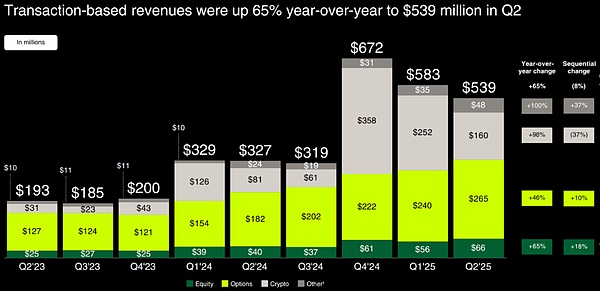
Meanwhile, Coinbase’s quarterly performance has been politely called “a challenging quarter.”
totalRevenue fell 26% from the first quarter to $1.5 billion, lower than analyst expectations.Trading revenue fell by 39% as retail trading shrinks.The company’s stock price fell 16% on the day of the financial report, and investors tried to figure out whether this was temporary or whether it was actually unwilling to pay high fees for complexity.
“We believe their growth is still at long-term risks due to higher than average retail trading fees and increased competition from platforms like Robinhood. Coinbase needs to implement lower transaction fees and continue to expand its product line through mergers and acquisitions to avoid losing market share.”
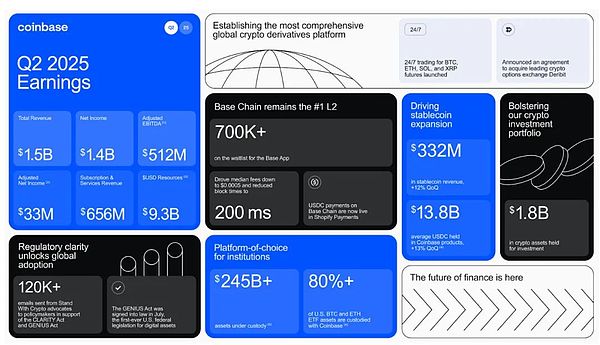
But calling this quarter a failure ignores the bigger picture.
Coinbase recorded $1.4 billion in net income,, which is due to the unrealized gains of $1.5 billion from portfolio and strategic crypto asset holdings.The book returns of these investments far exceed their core operating performance.
Even excluding these one-time earnings, adjusted net income still reached a solid $33 million.This was real profit in a weak quarter.
In-depth analysis, we can also find many commendable places.Operating expenses have risen, but are mainly due to a one-time loss of $307 million from the data breach in May.Core costs (such as technology, management, and marketing) have actually declined, indicating that cost control is indeed in place.Their USDC business continues to flourish with stablecoin revenue reaching $332 million, thanks to an average balance increase of 13%.Custody assets hit an all-time high of $245.7 billion.
The major financing balances also reached record levels.This is part of Coinbase Prime, an institutional service that is similar to traditional major brokerage businesses—they provide custody, trading, lending and financing services to hedge funds, family offices and other large crypto investors.Main financing specifically refers to margin loans, where institutions can use their crypto asset lending to make additional transactions or investments.
Coinbase continues to launch new products: launching new derivatives products, developing its Base chain, and launching the Coinbase One Card.While revenues are down, the foundation looks stronger than ever.
CoinbaThe infrastructure empire of se
Coinbase’s infrastructure strategy is more complex than it seems on the surface.They host $245.7 billion in assets for institutions—a record high and accounted for a considerable share of the entire institutional crypto market.When you buy a Bitcoin ETF through a 401k account, you are likely to be using Coinbase’s infrastructure.
Coinbase is the main custodian of more than 80% of Bitcoin and Ethereum ETFs in the United States, controlling $113.4 billion of approximately $140 billion in crypto ETF assets.When BlackRock’s IBIT or Fidelity’s FBTC needs to store billions of dollars in bitcoin, they look for Coinbase.When PayPal wanted to launch PYUSD stablecoins or JPMorgan needed to encrypt payment tracks, they used Coinbase’s backend.
Coinbase has over 240 institutional clients, over 420 liquidity providers, and regulatory licensing that most competitors cannot match.Its custody is licensed by the New York State Department of Financial Services.Such regulatory approvals took years to obtain, and it took many years for competitors to replicate.
Their “Equity Exchange” strategy began to show results outside of custody.They have just launched perpetual futures with up to 10 times leverage, bringing derivatives trading previously available only on overseas exchanges to U.S. retail traders.They integrate decentralized exchanges directly into their apps, so you can trade any tokens on Ethereum or Base without leaving Coinbase.
Coinbase’s Base secondary network handles over 54,000 token offerings in one day, surpassing Solana.What makes its true genius lies in the seamless integration of Base with other Coinbase businesses.ETF providers can use Base for instant settlement, and enterprises can tokenize assets directly on the Internet.And retail investors can use the same infrastructure as billion-dollar institutions.
Robinhood’s intergenerational takeover
While Coinbase builds infrastructure for institutions, Robinhood is executing what might be the smartest long-term strategy in financeslightly:Before a whole generation became richTake itthem.
This strategy has proven to be very successful.Disney built its empire by capturing the hearts of children in the early 20th century, far before they had their wallets.From cartoons to theme parks, Disney became a part of childhood.When these kids grow up and start making money, they bring loyalty to spend on movies, merchandise, streaming and vacations.This early emotional bond became a money-making machine for multiple generations.
Robinhood dominates young investors, which should worry traditional brokerage firms.
About 50% of Robinhood customers are millennials, about 25% are Gen Z and 20% are Gen X.
The average investment starting age for Robinhood users is 19-22 years old, compared with millennials on other platforms in their mid-20s and baby boomers in their 30s.
Robinhood will even guide new users to quickly complete the first sell operation.Not because they want users to trade frequently, but because locking in real returns creates an emotional bond that attracts users to invest again.Once someone makes real money on the platform, even if it is only $50, they will psychologically develop an inbreakable dependence on the platform.
Against this background, it is natural for them to enter the financial field.
Robinhood Gold is its $5 monthly subscription service that includes 3% cashback credit card, high yieldSavings, retirement matching and margin discounts.Gold subscribers grew 60% year-on-year to 2 million.These people use RobinhoodConduct banking, credit cards and retirement savings.
The platform currently holds $279 billion in custodial assets.The platform hopes that in the next 20 years,A piece of the pie from the “huge wealth transfer” that will involve $84 to $124 trillion in assets transferred from baby boomers to younger generations.
This wealth will be passed from the baby boomers to the younger generation over the next two decades.No one knows exactly who will get what or when.But Robinhood bets that if you can develop user habits early, there is no need to predict inheritance patterns.You just need to be prepared when the money comes out.
So, who is the winner?
The two companies have similar market capitalizations: Robinhood is $81 billion and Coinbase is $85 billion.Robinhood has risen 135% in performance this year, while Coinbase has risen only 30%, and most of the gains have come from the last month.
Bank of America analyst Craig Siegenthaler recently raised Robinhood’s target price to $119 while lowering Coinbase’s target price from $383 to $369.His reasoning is: “Robinhood’s crypto revenue is booming, and Coinbase is relying too much on volatile altcoin trading that retail investors are giving up.”
Coinbase’s global market share fell from 5.65% to 4.56%, rebounding slightly in July, while Kraken’s market share growth in the U.S. this year.Coinbase faces a classic dilemma: lowering prices will hurt profit margins, and insisting on high prices will risk losing traders.They make profits by charging fees for previously free stablecoin transactions, while Robinhood’s commission rate is still about 50% lower than Coinbase.
Mizuho reiterated his $120 price target after meeting with Robinhood CEO Vlad Tenev, citing the company’s resilience in the crypto space and actively pushing tokenized stocks.
“We are particularly impressed with the opportunity to tokenize stocks in Europe, the high-end market and potential expansion to teenagers, 15% of net deposits coming from competitors, focus on net recommendations (NPS) and execution as a key growth driver and inelastic demand for crypto prices,” said analysts.carve.”
But Coinbase has institutional credibility.Other exchanges are competing to reduce transaction fees, and Coinbase is building relationships with institutions that will determine how cryptocurrencies and traditional finance are integrated over the next decade.
Neither company will disappear.They meet completely different user needs, and these needs are growing.It’s not like a winner-take-all competition, but more like a market segment – Robinhood is aimed at mainstream finance, while Coinbase is aimed at crypto infrastructure.
This shows two opposing theories of people’s future interaction with money.
One theory holds that future finance will be invisible.It is abstract, simplified, built into various applications and feels more like a lifestyle product than a brokerage business.Finance will be integrated into life.This is Robinhood’s worldview.
Neither is right or wrong.They just aim at different targets.One tries to gain trust through simplicity, the other through architecturewin.


